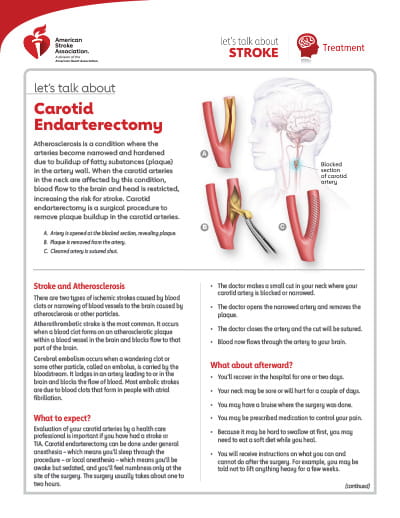Let’s Talk About Carotid Endarterectomy
 Atherosclerosis is a condition where the arteries become narrowed and hardened due to buildup of fatty substances (plaque) in the artery wall. When the carotid arteries in the neck are affected by this condition, blood flow to the brain and head is restricted, increasing the risk for stroke. Carotid endarterectomy is a surgical procedure to remove plaque buildup in the carotid arteries.
Atherosclerosis is a condition where the arteries become narrowed and hardened due to buildup of fatty substances (plaque) in the artery wall. When the carotid arteries in the neck are affected by this condition, blood flow to the brain and head is restricted, increasing the risk for stroke. Carotid endarterectomy is a surgical procedure to remove plaque buildup in the carotid arteries.
Stroke and Atherosclerosis
There are two types of ischemic strokes caused by blood clots or narrowing of blood vessels to the brain caused by atherosclerosis or other particles.
Atherothrombotic stroke is the most common. It occurs when a blood clot forms on an atherosclerotic plaque within a blood vessel in the brain and blocks flow to that part of the brain.
Cerebral embolism occurs when a wandering clot or some other particle, called an embolus, is carried by the bloodstream. It lodges in an artery leading to or in the brain and blocks the flow of blood. Most embolic strokes are due to blood clots that form in people with atrial fibrillation.
What to expect?
Evaluation of your carotid arteries by a health care professional is important if you have had a stroke or TIA. Carotid endarterectomy can be done under general anesthesia – which means you’ll sleep through the procedure – or local anesthesia – which means you'll be awake but sedated, and you’ll feel numbness only at the site of the surgery. The surgery usually takes about one to two hours.
- The doctor makes a small cut in your neck where your carotid artery is blocked or narrowed.
- The doctor opens the narrowed artery and removes the plaque.
- The doctor closes the artery and the cut will be sutured.
- Blood now flows through the artery to your brain.
What about afterward?
- You’ll recover in the hospital for one or two days.
- Your neck may be sore or will hurt for a couple of days.
- You may have a bruise where the surgery was done.
- You may be prescribed medication to control your pain.
- Because it may be hard to swallow at first, you may need to eat a soft diet while you heal.
- You will receive instructions on what you can and cannot do after the surgery. For example, you may be told not to lift anything heavy for a few weeks.
- Ask your doctor when you can return to work.
- Your doctor will prescribe medications such as aspirin, clopidogrel or the combination of aspirin and dipyridamole to prevent further blood clotting.
- You should make healthy lifestyle changes to help reduce new plaque deposits and lower your risk of stroke.
How can I reduce my risk of stroke?
- Have your blood pressure checked often and manage high blood pressure.
- Don’t smoke and avoid second-hand smoke.
- Reach and maintain a healthy weight.
- Get regular physical activity.
- Have your blood sugar tested, and control diabetes if you have it.
- Eat less salt, saturated fat and trans-fat such as fried foods.
- Limit alcohol to no more than two drinks a day for men, one drink a day for women.
- Take your medications exactly as prescribed.
How can I learn more?
- Call 1-888-4-STROKE (1-888-478-7653) or visit stroke.org to learn more about stroke or find local support groups.
- Sign up for our monthly Stroke Connection e-news for stroke survivors and caregivers at StrokeConnection.org.
- Connect with others who have also had an experience with stroke by joining our Support Network at stroke.org/SupportNetwork.
Do you have questions for your doctor or nurse?
Take a few minutes to write down your questions for the next time you see your health care professional. For example:
Could I have a stroke during surgery?
Will I need a surgery again?
We have many other fact sheets to help you make healthier choices, manage your condition or care for a loved one.
Visit stroke.org/LetsTalkAboutStroke to learn more
© Copyright 2022 American Heart Association, Inc., a 501(c)(3) not-for-profit. All rights reserved. American Stroke Association is a registered trademark of the AHA. Unauthorized use prohibited. DS18977 3/22